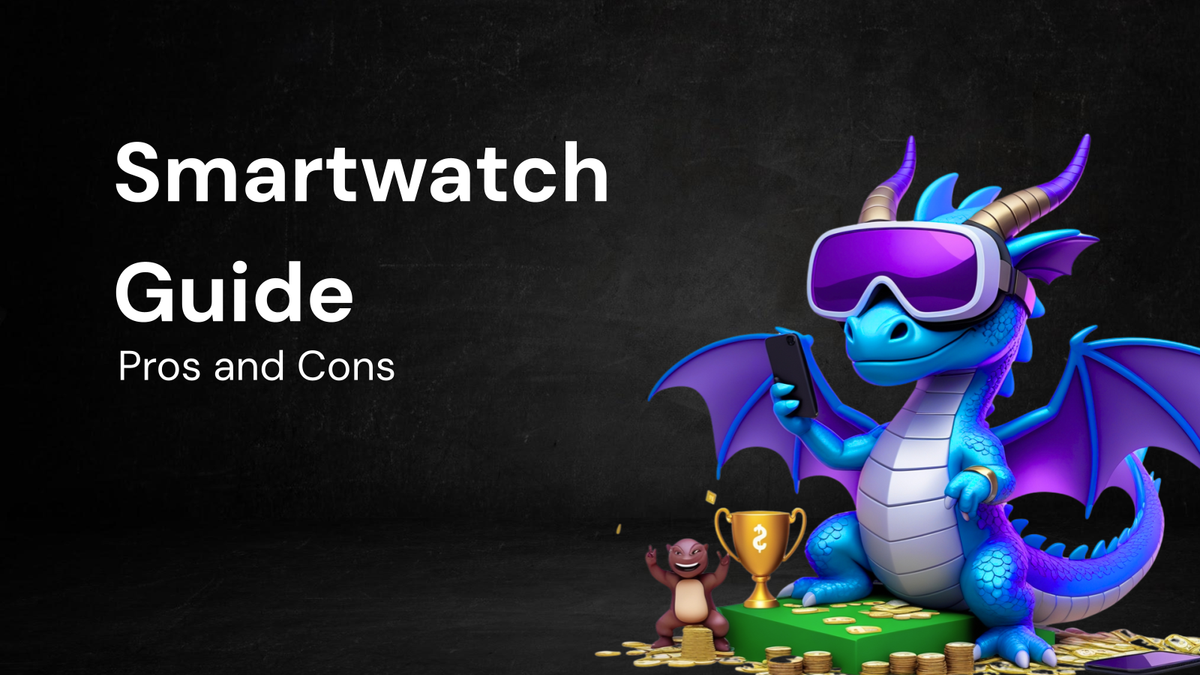Smartwatch Guide: Weighing the Pros and Cons

Smartwatch Guide: Weighing the Pros and Cons
The smartwatch has evolved from a futuristic gadget seen in sci-fi movies to a mainstream wearable, gracing the wrists of millions. These miniature computers pack a surprising punch, offering a plethora of features ranging from fitness tracking and communication to mobile payments and entertainment. But are smartwatches truly essential, or just another tech fad? This guide dives deep into the world of smartwatches, weighing the pros and cons to help you decide if one is right for you.
What is a Smartwatch?
At its core, a smartwatch is a wearable computer that resembles a traditional wristwatch. It connects to your smartphone via Bluetooth, expanding its functionality and providing convenient access to information and features on your wrist. Unlike simple fitness trackers, smartwatches offer a more comprehensive experience, including app support, notifications, communication capabilities, and even standalone functionality.
The Pros of Owning a Smartwatch:
- Convenience and Accessibility:
- Notifications at a Glance: The most immediate benefit of a smartwatch is the ability to receive notifications directly on your wrist. Instead of constantly pulling out your phone to check emails, texts, social media updates, or calendar reminders, you can simply glance at your smartwatch. This is particularly useful during meetings, workouts, or when your phone is tucked away in your bag.
- Hands-Free Communication: Many smartwatches allow you to answer calls and respond to text messages directly from your wrist. This can be a lifesaver when you're driving, cooking, or otherwise occupied. Some models even feature built-in cellular connectivity, allowing you to make calls and send texts even without your phone nearby.
- Quick Access to Information: Smartwatches provide quick access to a wealth of information, from weather forecasts and news headlines to stock prices and sports scores. You can customize the watch face to display the information that's most relevant to you, ensuring that it's always just a glance away.
- Fitness and Health Tracking:
- Comprehensive Activity Monitoring: Smartwatches are equipped with a variety of sensors that track your activity levels throughout the day. They typically monitor steps taken, distance traveled, calories burned, heart rate, and sleep patterns. This data can help you understand your fitness habits and identify areas for improvement.
- Workout Tracking and Guidance: Many smartwatches offer dedicated workout tracking modes for various activities, such as running, cycling, swimming, and weightlifting. They can track your performance metrics, provide real-time feedback, and even offer guided workouts to help you achieve your fitness goals.
- Health Monitoring Features: Some smartwatches go beyond basic fitness tracking and offer advanced health monitoring features, such as ECG (electrocardiogram) readings, blood oxygen saturation (SpO2) monitoring, and fall detection. These features can provide valuable insights into your health and potentially alert you to underlying medical conditions.
- Motivation and Gamification: Smartwatches often use gamification techniques, such as awarding badges and trophies, to motivate you to stay active and achieve your fitness goals. They can also connect you with friends and family, allowing you to compete in challenges and share your progress.
- Enhanced Productivity and Efficiency:
- Task Management: Smartwatches can help you stay organized and on top of your to-do list. You can set reminders, manage appointments, and even control smart home devices directly from your wrist.
- Mobile Payments: With NFC (Near Field Communication) technology, many smartwatches allow you to make contactless payments at participating merchants. This eliminates the need to carry your wallet or phone, making it quick and convenient to pay for purchases.
- Navigation and Location Services: Smartwatches with built-in GPS can provide turn-by-turn navigation, helping you find your way around unfamiliar areas. They can also track your location during outdoor activities, such as hiking and cycling.
- Voice Control and Assistants: Many smartwatches integrate with voice assistants like Siri, Google Assistant, or Alexa, allowing you to control your device and access information using voice commands. This can be particularly useful when your hands are full or when you're on the go.
- Safety and Security:
- Emergency SOS: Many smartwatches have an emergency SOS feature that allows you to quickly contact emergency services or designated contacts in case of an accident or medical emergency.
- Fall Detection: Some smartwatches can detect when you've fallen and automatically alert emergency services or your emergency contacts. This can be particularly useful for elderly individuals or those with mobility issues.
- Find My Device: If you misplace your phone, you can use your smartwatch to locate it by ringing it or displaying its last known location on a map.
- Unauthorized Access Alerts: Some smartwatches can detect when someone is trying to access your device without your permission and alert you accordingly.
- Style and Personalization:
- Customizable Watch Faces: Smartwatches offer a wide variety of customizable watch faces, allowing you to personalize the look of your device to match your style and preferences.
- Interchangeable Bands: Most smartwatches allow you to easily swap out the watch band, allowing you to further customize the look of your device and adapt it to different occasions.
- Variety of Designs and Styles: Smartwatches come in a wide range of designs and styles, from sleek and minimalist to sporty and rugged. This ensures that you can find a smartwatch that fits your personal aesthetic.
The Cons of Owning a Smartwatch:
- Battery Life:
- Frequent Charging: One of the biggest drawbacks of smartwatches is their limited battery life. Most smartwatches require daily or bi-daily charging, which can be inconvenient for some users.
- Battery Drain with Heavy Usage: Using features like GPS, heart rate monitoring, and cellular connectivity can significantly drain the battery, reducing the time between charges.
- Reliance on Charging Cradles: Smartwatches typically require proprietary charging cradles or cables, which can be easily lost or misplaced.
- Price:
- Significant Investment: Smartwatches can be a significant investment, with prices ranging from a few hundred dollars to well over a thousand dollars for high-end models.
- Recurring Costs: In addition to the initial purchase price, you may also incur recurring costs for cellular connectivity, premium app subscriptions, and replacement bands.
- Depreciation: Like other electronic devices, smartwatches depreciate in value over time, meaning you may not be able to recoup your investment if you decide to sell it later.
- Complexity and Learning Curve:
- Intricate Features and Settings: Smartwatches can be complex devices with a multitude of features and settings, which can be overwhelming for some users.
- App Management and Customization: Managing apps, customizing watch faces, and configuring notifications can require a significant amount of time and effort.
- Software Updates and Troubleshooting: Smartwatches require regular software updates, which can sometimes introduce bugs or compatibility issues. Troubleshooting these issues can be frustrating for non-technical users.
- Dependence on Smartphone:
- Limited Standalone Functionality: While some smartwatches offer cellular connectivity, most rely on a smartphone for many of their core functions, such as making calls, sending texts, and accessing the internet.
- Bluetooth Connectivity Issues: Maintaining a stable Bluetooth connection between your smartwatch and smartphone can sometimes be problematic, leading to dropped connections and missed notifications.
- Compatibility Issues: Some smartwatches are only compatible with certain smartphone operating systems (e.g., Apple Watch with iOS), limiting your choice of devices.
- Screen Size and Readability:
- Small Screen Size: The small screen size of smartwatches can make it difficult to read text, view images, and interact with apps.
- Limited Touchscreen Accuracy: The small touchscreen can also be challenging to use, especially for users with larger fingers.
- Glare and Visibility Issues: The screen can be difficult to see in bright sunlight due to glare and limited brightness.
- Distraction and Interruptions:
- Constant Notifications: The constant stream of notifications on your wrist can be distracting and interrupt your focus.
- Social Media Addiction: The ease of accessing social media on your smartwatch can exacerbate social media addiction and lead to decreased productivity.
- Privacy Concerns: Smartwatches collect a significant amount of personal data, including your location, activity levels, and health information, which raises privacy concerns.
- Durability and Repairability:
- Fragile Construction: Smartwatches are generally more fragile than traditional watches and can be easily damaged by impacts or scratches.
- Limited Water Resistance: While some smartwatches are water-resistant, they may not be suitable for swimming or other water activities.
- Expensive Repairs: Repairing a damaged smartwatch can be expensive, and in some cases, it may be more cost-effective to replace it altogether.
Who Should Consider Buying a Smartwatch?
- Fitness Enthusiasts: Smartwatches are an excellent tool for tracking fitness activities, monitoring health metrics, and staying motivated to achieve fitness goals.
- Tech-Savvy Individuals: If you're comfortable with technology and enjoy exploring new gadgets, a smartwatch can be a fun and useful addition to your tech arsenal.
- Busy Professionals: Smartwatches can help busy professionals stay organized, manage their schedules, and communicate efficiently.
- Individuals Seeking Convenience: If you value convenience and want to access information and features without having to pull out your phone, a smartwatch can be a worthwhile investment.
Who Should Reconsider Buying a Smartwatch?
- Budget-Conscious Individuals: Smartwatches can be a significant expense, and there are often more affordable alternatives for specific features, such as fitness trackers.
- Those Seeking Simplicity: If you prefer a simple and straightforward wristwatch, a smartwatch may be too complex and overwhelming.
- Individuals Concerned About Privacy: If you're concerned about the privacy implications of collecting personal data, you may want to reconsider buying a smartwatch.
- Those Prone to Distraction: If you're easily distracted, the constant stream of notifications on a smartwatch may negatively impact your productivity and focus.
Conclusion:
Smartwatches offer a compelling blend of convenience, functionality, and style. They can be a valuable tool for fitness tracking, communication, productivity, and even safety. However, they also come with drawbacks, such as limited battery life, high price, and potential for distraction.
Ultimately, the decision of whether or not to buy a smartwatch depends on your individual needs, priorities, and budget. Carefully weigh the pros and cons outlined in this guide, consider your own usage patterns, and choose a smartwatch that aligns with your lifestyle and preferences. Don't fall for the hype; instead, make an informed decision based on what you truly need and will use. By doing so, you can determine if a smartwatch is a truly valuable addition to your life, or simply another gadget gathering dust.




